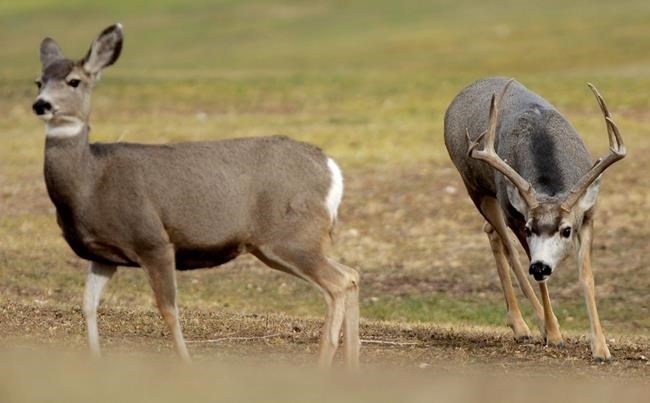
A mule deer buck shows interest in a doe on a fairway at the Anaconda Hills golf course in Great Falls, Mont., on Thursday, Nov. 15, 2007. A southern Alberta police officer caught on video repeatedly running over an injured deer will not be charged.
Image Credit: THE CANADIAN PRESS/AP, Great Falls Tribune, Robin Loznak
June 26, 2019 - 4:30 PM
LETHBRIDGE, Alta. - A southern Alberta police officer caught on video repeatedly running over an injured deer will not be charged after the province's police watchdog determined it saw no better way to end the animal's suffering.
Greg Gudelot, a lawyer with the Alberta Serious Incident Response Team, said the emotional impact cannot be understated of a 15-minute bystander video that shows the marked police pickup truck driving and reversing over the young female mule deer.
"It was and remains profoundly distressing and heartbreaking to watch," Gudelot said in Lethbridge on Wednesday. "It is unforgettable and impossible to unsee."
But ASIRT said its investigation — done with the help of Alberta Fish and Wildlife and the Alberta Society for the Prevention of Cruelty to Animals — had to be based on evidence, not sympathy or public pressure.
The Lethbridge Police Service was extremely busy the night of Jan. 5, when calls came in of an injured deer on a road.
The officer, who ASIRT is not identifying, was working alone when he found the animal with severe injuries to its hindquarters and back legs.
Shooting the animal would have killed it quickly, but the officer decided a bullet could have ricocheted and hit someone in nearby homes or vehicles.
ASIRT determined that was not an unfounded worry. When an officer shot an injured deer north of Toronto in 2015, a bullet went through the animal, bounced off a sidewalk and struck a 78-year-old man in the head. The senior survived.
The agency said dragging the animal to a secluded location to be shot would have prolonged its suffering. And the animal, agitated and still able to kick with its sharp front hooves, could have injured the officer if he got close enough to beat it with a baton or slit its throat with a knife.
The officer did not contact Fish and Wildlife officers. But even so, none were working in Lethbridge at the time and the closest was about an hour away.
There was no protocol for calling a local veterinarian and ASIRT said doing so from the side of the road after 10 p.m. would have been challenging.
"The police vehicle may well have been the best in a pool of bad choices," said Gudelot.
He said the officer believed a crushing blow with the truck would kill the deer quickly. But with the benefit of hindsight, it was a problematic choice as it took multiple tries and 15 minutes for the animal to finally die.
"It did not work as the officer had intended," said Gudelot.
"The deer's ability to move and the inability of the officer to clearly see where the vehicle tires were in relation to the critical organs of the deer frustrated the attempts to cause fatal injury. That having been said, no method is perfect and complications or problems can occur."
ASIRT executive director Susan Hughson said this is the first animal death her agency has investigated. She didn't know how many calls police officers get to euthanize wildlife.
The agency doesn't normally make recommendations, but she said both she and the Crown think law enforcement should look at ways to work with veterinarians on these calls.
"The reality is, if you're euthanizing an injured animal, there's really not a good way of doing it or a pretty way of doing it other than by sedation."
— by Lauren Krugel in Calgary
News from © The Canadian Press, 2019